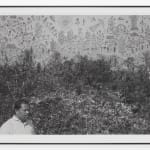-
Artworks


Bohada, from the series Fields of Sight, 2021
Acrylic paint on Archival pigment print42 x 62 in.
106.7 x 157.5 cm
Framed: 49 x 68 1/4 in.
124.5 x 173.4 cmSoldSince 2013, Gill and renowned Warli painter Rajesh Vangad have worked together on Fields of Sight, a series of photographs taken by Gill and then hand-inscribed in black paint by...Since 2013, Gill and renowned Warli painter Rajesh Vangad have worked together on Fields of Sight, a series of photographs taken by Gill and then hand-inscribed in black paint by Vangad, co-creating new imagery of life in Ganjad, a small farming village. These fantastical works combine the contemporary language of photography with that of ancient Warli drawing, a genre of folk art which utilizes the geometric vocabulary of circles, triangles, and squares to symbolize different elements in nature, and the world. In this work, Vangad has depicted the annual Bohada dance festival in Maharashtra, where the Kokna and Warli tribes from the Adivasi indigenous tribal communities enact scenes from Hindu epics and tribal myths, wearing masks personifying their own gods and goddesses, demons, animal representations and figures from nature. The festival often commences with the first mask representing Suraj Dev, or the sun. Here, a radial sun illuminates the scene of community members donning masks and dancing in a carnivalesque procession. Gill drew her initial inspiration for her series of color photographs "Acts of Appearance" from the Bohada festival; working collaboratively with a team of more than thirty artists and volunteers to go beyond the confines of their traditional mask-making and develop a new set of forms based on contemporary figures as seen in the village.
Warli painting is an indigenous art form; the Warli are Adivasi or so called ‘scheduled tribes’ in India, whose land rights have consistently been under threat, from the period of British Colonial rule right up to the present moment of political and environmental instability. Scheduled and lower castes occupy a precarious socio-economic position in India, and their status
is heavily politicized. Tribal craft, especially in the decades following decolonization, was supported by various state and non-governmental initiatives to preserve and industrialize Indian workmanship. Rajesh Vangad, who learned the art form from his mother, and later from the legendary artist Jivya Soma Mashe, is one of the leading practitioners of this form today. After conversations with Vangad while spending time with him in the village working on a common project, Gill began to photograph him in places that had special meaning for him.Exhibitions
A Time to Play: New Scenes from Acts of Appearance, James Cohan, 52 Walker Street, New York, NY, October 7 - November 13, 20211of 2



